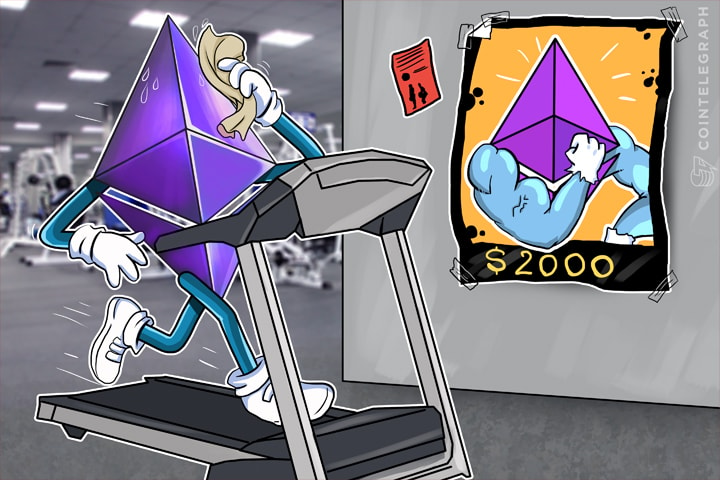When Ether reaches a price of $2,000, we are looking at a market capitalization of around $188 bln. Although this is significantly higher than today, an eight-time increase, it is still relatively small if we compare it to the market capitalization of a company like Facebook, $492 bln.
Cointelegraph attempts to analyze what events need to occur in order for Ether to break this mark.
Raiden network
Currently, the Ethereum network is limited to around 20 transactions per second. This is twice as much as Bitcoin can handle. However, if we are looking at a future where Ethereum is used as a daily form of payment, this isn’t enough.
The Raiden Network is aiming to solve this problem. Its developers are building an off-chain solution for Ethereum payments which scales linearly with the number of participants. The network could in the future handle over 1,000,000 transactions per second.
Additionally, it will allow decreasing transaction cost by seven orders of magnitude, making true micro-transactions on Ethereum a reality.
Ether becomes easier to acquire and spend
So far there are around 60 active cryptocurrency exchanges. This number is growing every single month as digital assets become more and more attractive. However, the average American is not comfortable with buy and sell limits and trading charts.
Therefore, new alternatives need to arise that allow the crowd to acquire Ether. Companies like Dether are working on platforms that allow interested parties to purchase Ether directly with cash. This is definitely a big step in the right direction.
At the time I’m writing this article, the market capitalization of all cryptocurrencies combined sits at around $110 bln. However, most owners of currencies like Ether and Bitcoin don’t actively spend their coins; they use them as an investment.
In order to see Ether at $2,000, more people need to start using it as a form of payment, and more vendors need to start accepting it. This would prove that Ether is a viable method of value exchange.
Zk-SNARKs
Members of the Ethereum Research and Development team and ZCash are collaborating on a research project addressing privacy on the Blockchain.
The integration of the tech behind ZCash into Ethereum is a key milestone. It will allow to completely anonymize transactions and certain components of smart contracts. This would make Ethereum ready to be used in scenarios we can’t even imagine yet.
A possible application of this privacy protocol could be in presidential elections or auctions. Once zk-SNARKs is fully integrated, the results of an election or auction could be verified by any observer of the Blockchain, but the individual votes or bids are not revealed.
ICOs become preferred method of funding, and solid regulations are in place
So far, over $1 bln was invested in ICOs by contributors from all over the world. That’s a very impressive figure keeping in mind that this method of funding was practically non-existent before the launch of Ethereum in 2015.
Most startups that hold an ICO, issue Ethereum-based tokens. Therefore, it was also one of the most important growth catalysts for the network in early 2017. ICOs have proven to be an extremely efficient method of funding, enabling hundreds of startups to raise enough money to start operations.
The SEC and the Monetary Authority of Singapore have clarified in many instances that some of the tokens sold through crowdsales are actually securities and need to adhere to its respective regulations. Despite this, most ICOs still issue tokens that would be declared illegal by most authorities.
Once this gray area is solved, Ether will likely see a lot of new money flowing in, and more investors getting involved in token sales.
EEA members switch from private chain to public chain
The Enterprise Ethereum Alliance (EEA) connects companies with Ethereum experts. Some notable members of the alliance are Microsoft, JP Morgan, Credit Suisse and Intel. The objective of the EEA is to solve the problems of large corporations using the Ethereum Blockchain and the Ether token.
Until now, most of the integrations these companies have built are working on private chains. However, private chains don’t interact directly with the Ethereum network and therefore don’t use Ether.
It is fair to assume that just like there was a massive shift from Intranets to the Internet, there might also be a transition from private chains to public chains once the technology is ready.
This would considerably increase the daily transactions that go through the Ethereum network.
Proof of Stake (PoS)
The current supply of Ether is around 93 mln coins. Vitalik Buterin has pointed out many times that the total supply will probably never surpass 100 mln if PoS is correctly integrated.
If Ethereum switches successfully to PoS, there will be a significant drop in the daily issuance rate of Ether. This means that less Ether will be created every day, thus reducing the total supply of the coin.
Additionally, once PoS is activated, Ether investors can opt to use their stake to verify other transactions in the network. In exchange, they will receive rewards paid out in this cryptocurrency.
This will very likely attract a new wave of investors seeking cash flow producing assets.
Until now, $2,000 Ether is still just fuel for our imagination. However, the technology has very solid fundamentals and many announcements to come.
With the support of a growing community, everything is possible.


